Moore-Jackson Cemetery (Hidden Cemeteries)
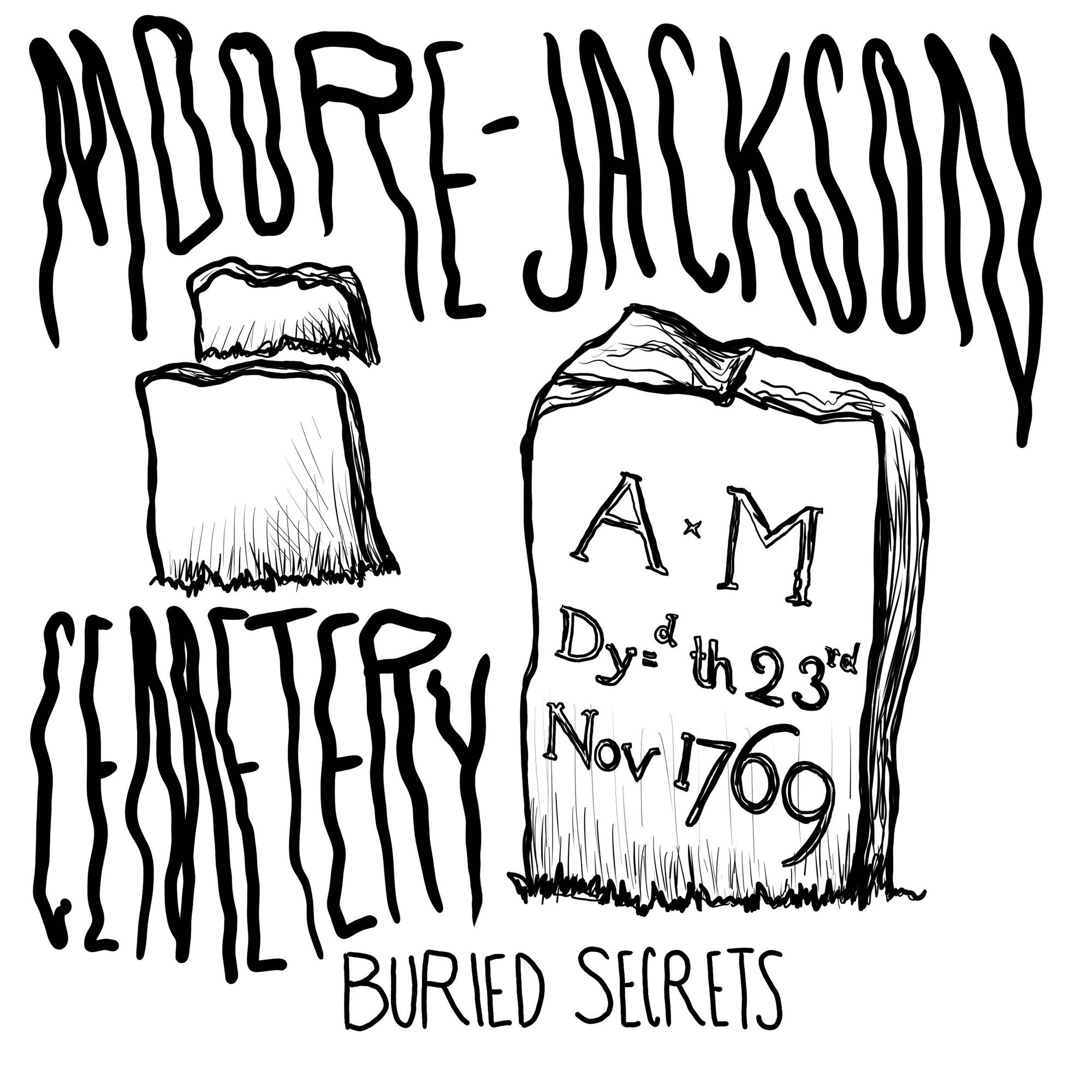
The Moore-Jackson Cemetery, a colonial-era cemetery sits in a quiet residential part of Woodside, Queens, in New York City.
Forgotten for years, and even used as a dump for construction materials and other detritus, the Moore-Jackson Cemetery recently been transformed into a beautiful community garden. Here’s the story behind the cemetery and the people buried there.
Highlights include:
• Loyalists living in Revolutionary War-era Queens, NY
• The city trying to illegally seize the cemetery at the behest of a developer
• A hot-potato cemetery
Check out the Moore-Jackson Cemetery/Garden’s website for more info and historical articles: https://www.moorejacksonnyc.org/
Pictures of the Moore-Jackson Cemetery
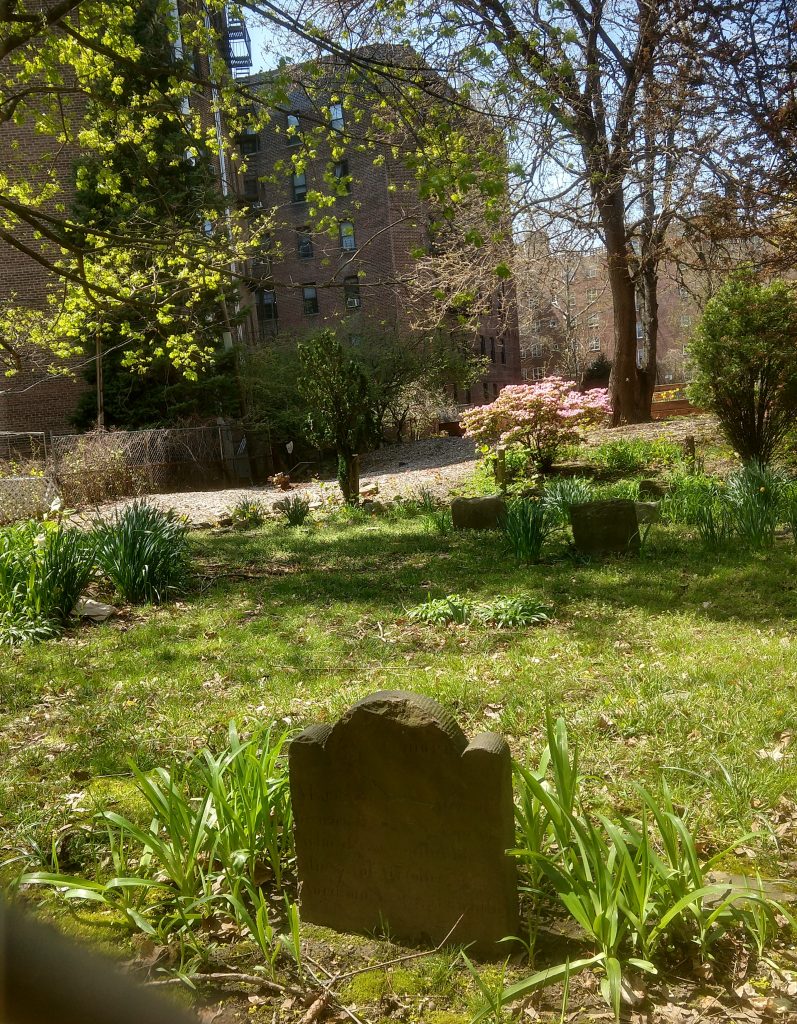
Moore-Jackson Cemetery in Spring 2020
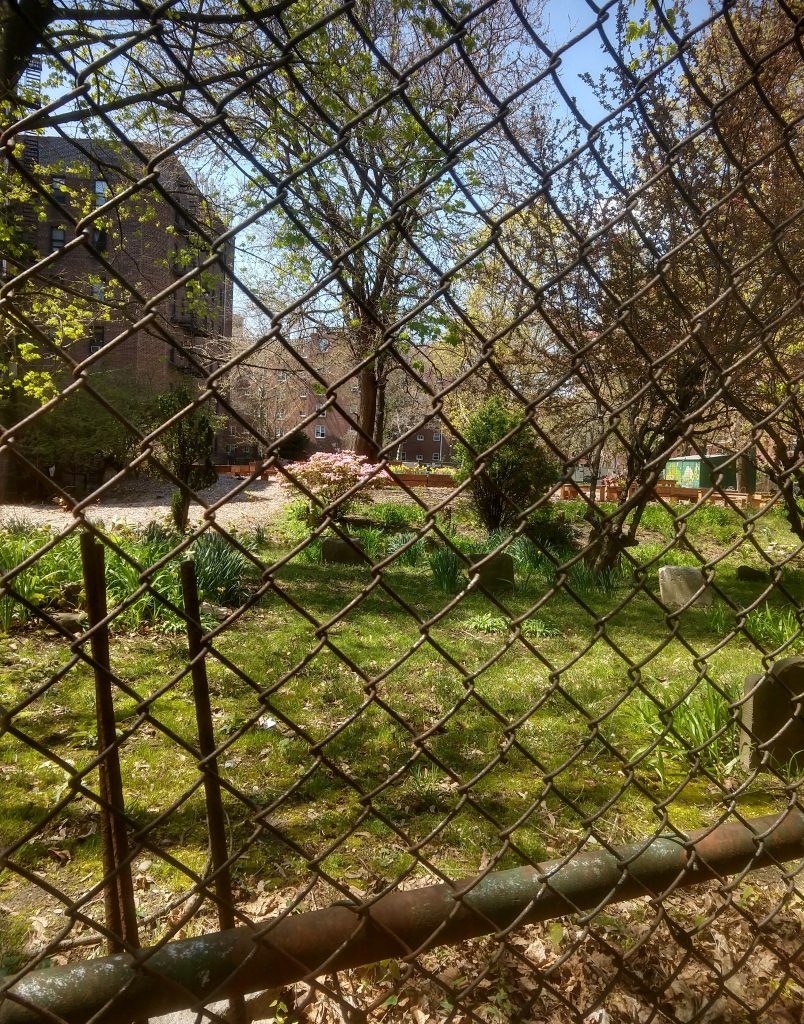
Moore-Jackson Cemetery in Spring 2020
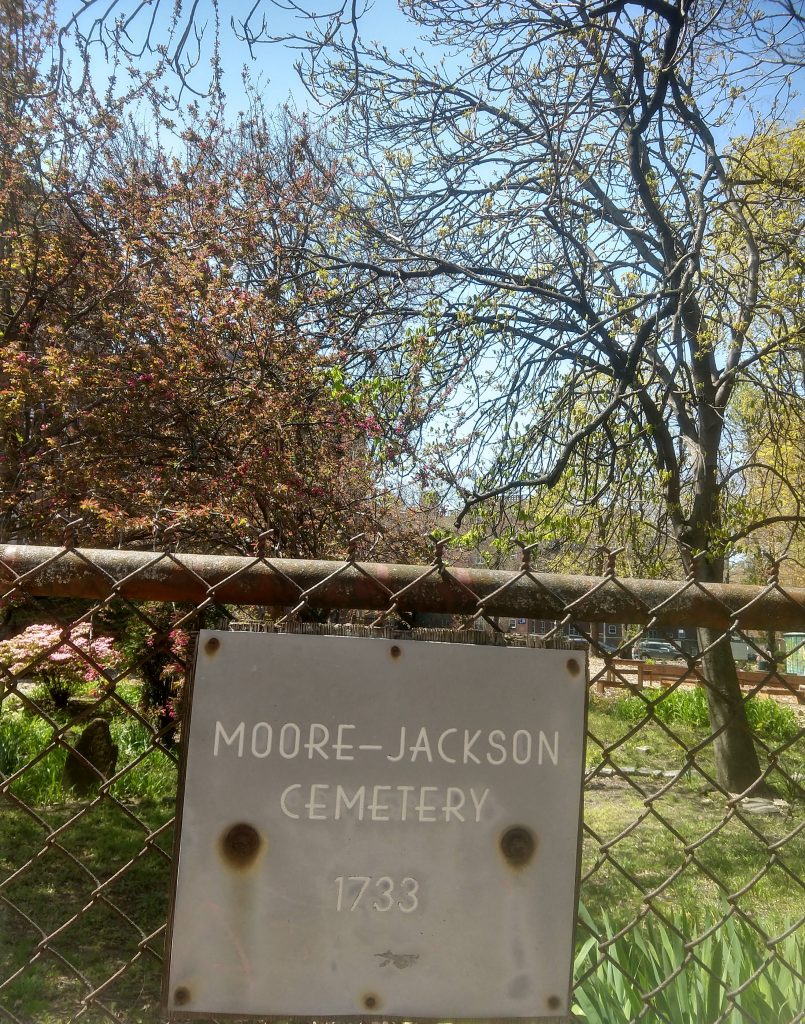
Moore-Jackson Cemetery in Spring 2020
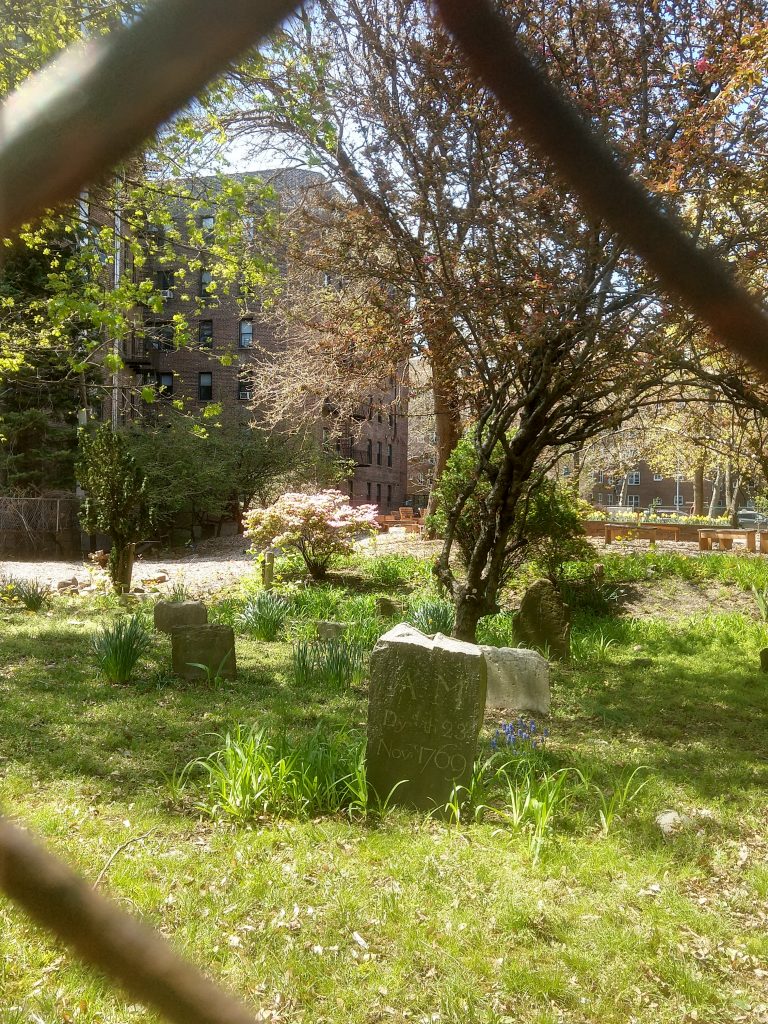
Moore-Jackson Cemetery in Spring 2020
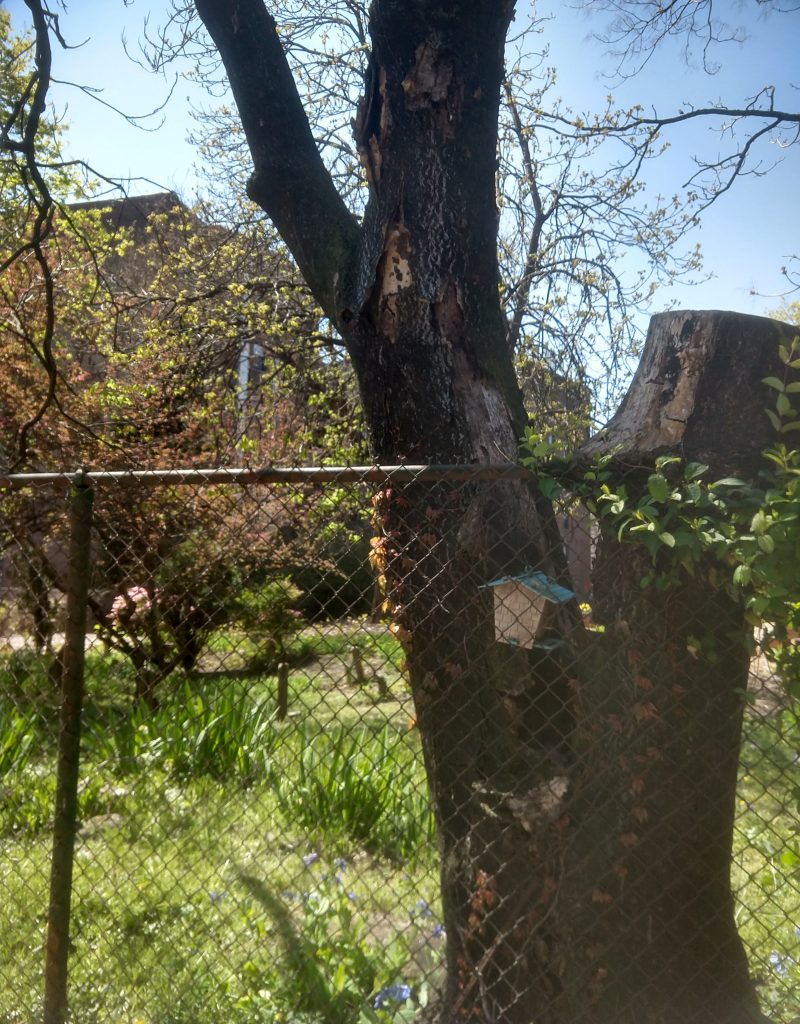
Moore-Jackson Cemetery in Spring 2020
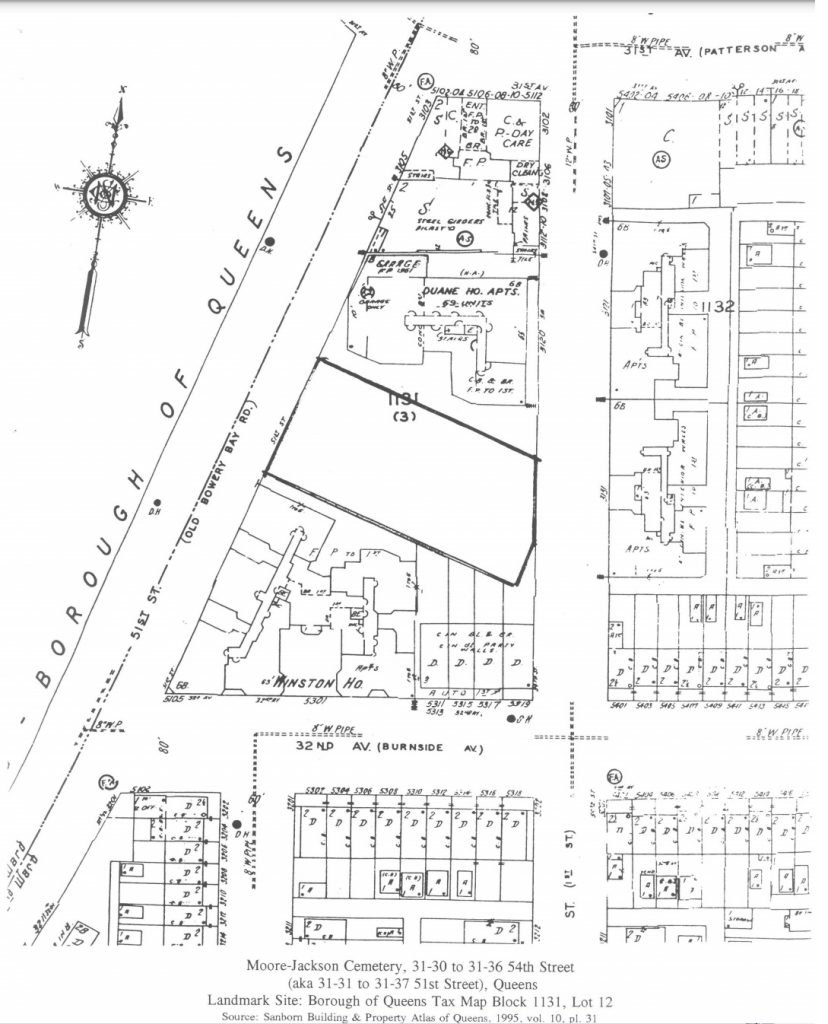
From the March 18, 1997, Landmark Preservation Commission report on Moore-Jackson Cemetery
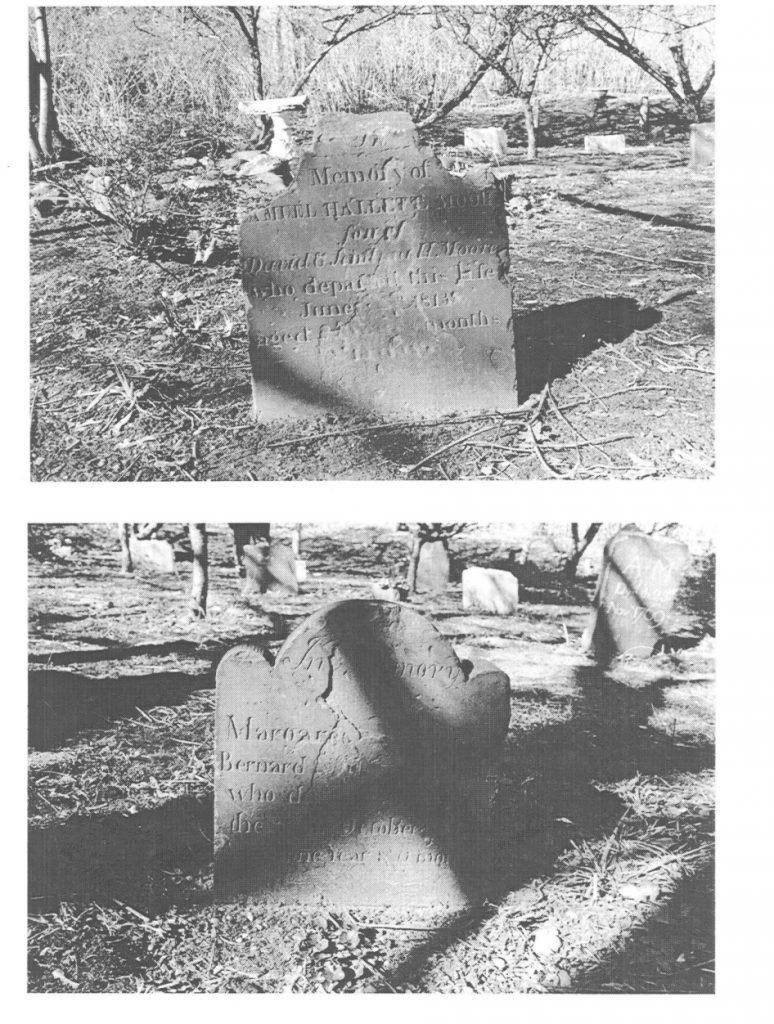
From the March 18, 1997, Landmark Preservation Commission report on Moore-Jackson Cemetery
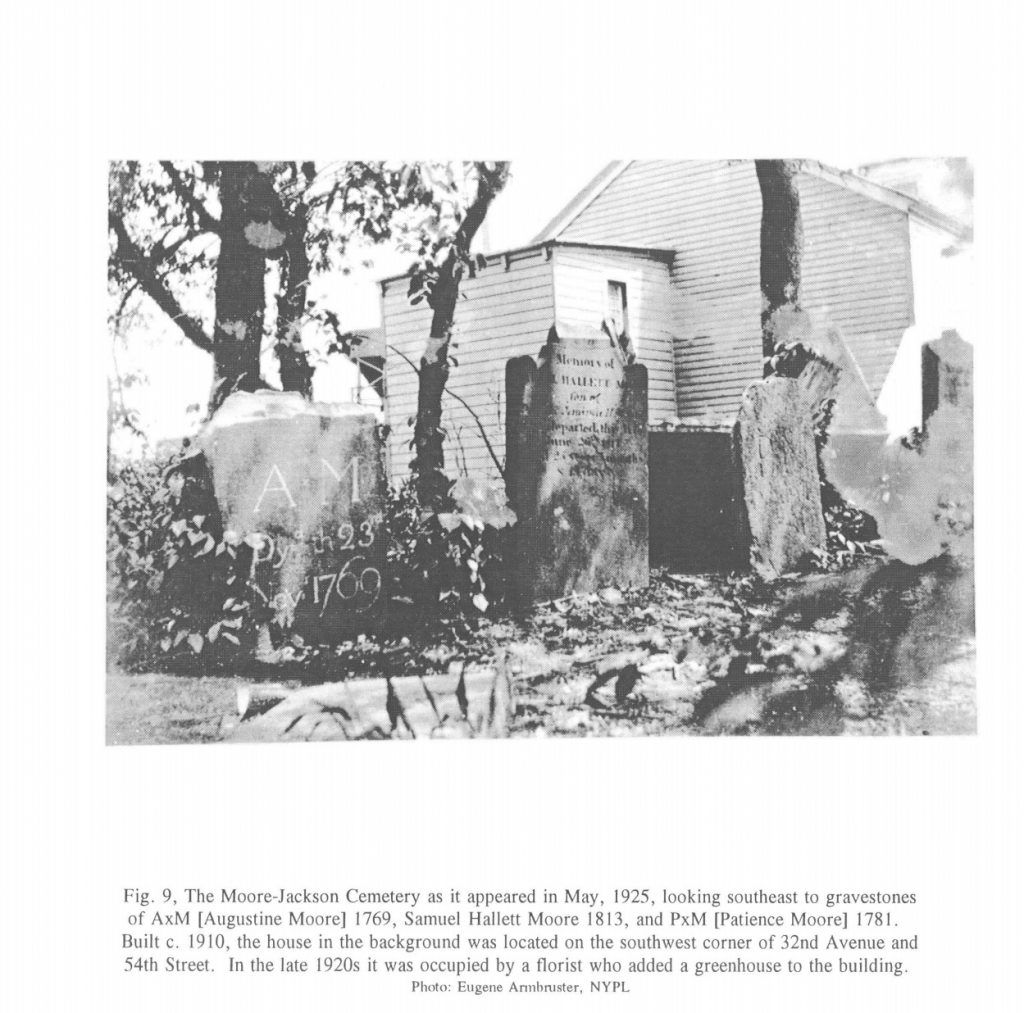
From the March 18, 1997, Landmark Preservation Commission report on Moore-Jackson Cemetery
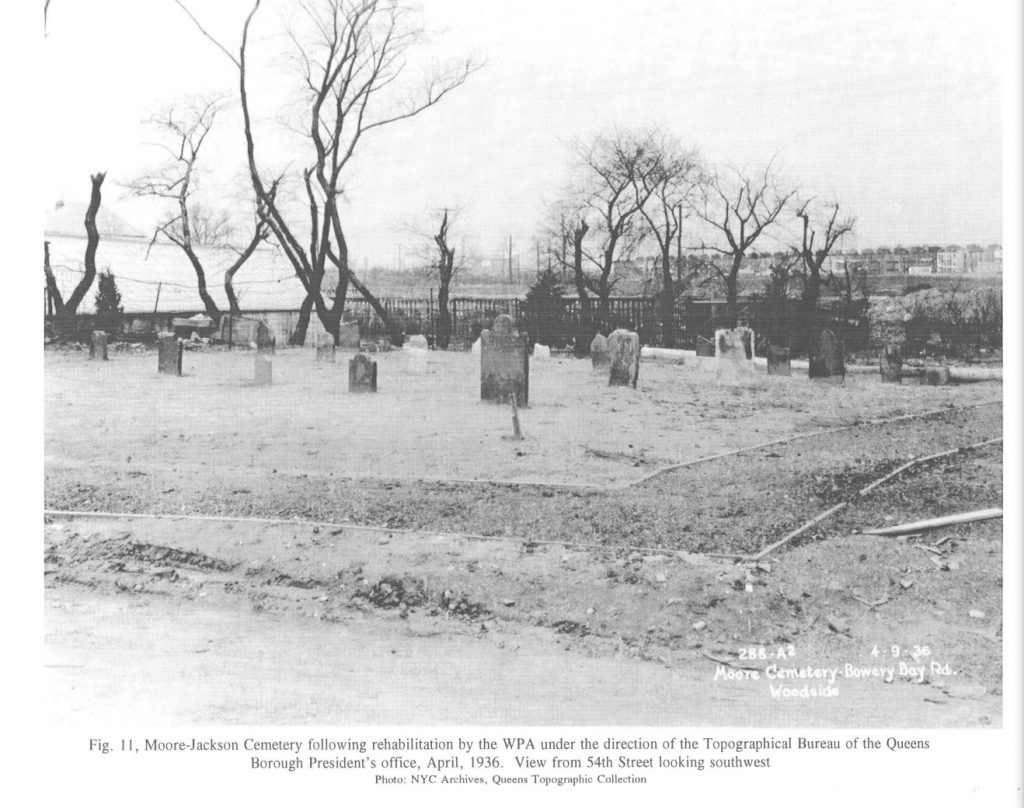
From the March 18, 1997, Landmark Preservation Commission report on Moore-Jackson Cemetery
Episode Script for the Moore-Jackson Cemetery
DISCLAIMER: I’m providing this version of the script for accessibility purposes. It hasn’t been proofread, so please excuse typos. There are also some things that may differ between the final episode and this draft script. Please treat the episode audio as the final product.
- Back when I originally became aware of this cemetery, in 2012, this was a forgotten colonial cemetery easily mistaken for an empty lot, a few blocks away from my old apartment). Out of all of the abandoned cemeteries I’ve talked about so far for this series, this is the first one I learned about, totally by accident, and the one I spent the most time near. I walked by it twice a day 5 days a week on my way to and from the subway, since it’s on 54th street and 31st avenue in Woodside, a block or so away from the subway.
- I remember shortly after I moved to Woodside, I was walking by what seemed like an empty lot, and then I realized there was a small sign on it that said Moore-Jackson Cemetery. It was completely overgrown, and it was really hard to see the headstones. It’s basically just sandwiched between some apartment buildings, and it’s really small, about half an acre.
- Since then the cemetery has found a new life as a community garden and it looks really different–it’s great that it’s been cleaned up and is now both better maintained but also able to be a place for the community to have access to.
- So let’s look at the history of this cemetery. First off, who were the Moores?
- You will have heard of the Moores because Clement Clark Moore, a member of the family, wrote Twas the Night Before Christmas. Clement C. Moore was famous for having lived on his family estate, Chelsea, in Manhattan, though. Clement C. Moorewas not a great dude–as a professor at Columbia, he argued against abolition. He became very rich selling off parts of Chelsea, which of course became the neighborhood we now know today as Chelsea.
- But the Moores we’re looking at today are the Queens Moores.
- According to the 1920 book Queens Borough, New York City, 1910-1920, the Moores built a house at Broadway and what was then known as Shell Road, in 1661. I think that shell road is now 45th Avenue, according to something I read in Forgotten New York. The house was built by Captain Samuel Moore, who was the son of Reverend John Moore.
- Reverend John Moore was the great-great-great grandfather of Clement C. Moore, btw.
- John Moore apparently laid out the area of Newtown–when I read that, I assumed that meant that he decided where the streets were, etc.
- But it actually sounds like his “contribution” went beyond that. John Moore supposedly purchased the Newtown from the Mespeatches tribe, for whom the present-day neighborhood of Maspeth is named.
- However, something to know here is that these sorts of “purchases” should be seen as very suspect. I’ve been doing some research on this and want to talk more about it on a future episode.
- But to get back to the Moore home:
- As of 1920, it was still standing, and still owned by the Moore family, though the Board of Transportation bought it in 1930.
- I wanted to read a bit from a Forgotten New York article about the site:
- “In the Dirty Thirties, NYC was relentless about bulldozing or otherwise destroying historic properties before preservation laws were on the books, and the Moore homestead didn’t survive the construction of the new IND subway under Broadway in 1933. . . . Meanwhile, two Moore burying grounds survive: a hidden one in a playground at 90th Street and 56th Avenue, and the Moore-Jackson Cemetery on 54th Street between 31st and 32nd Avenues in Woodside.”
- Out of the two cemeteries, the one we’re interested in is the 54th street site.
- The cemetery was established in 1733, and the final burial in the cemetery was in 1867. The Moores used to have a farm nearby, which Samuel Moore bought in 1684. The property had a farmhouse that stood from 1705-1901.
- It’s the Moore family cemetery, but it’s called the Moore-Jackson Cemetery because a man named John Jackson married into the family. It sounds like he owned a lot of land so it really increased the family’s land holdings. Jackson wasn’t actually buried in Moore-Jackson cemetery, however: he’s buried in Elmhurst, Queens, in the churchyard of St. James Episcopal Church.
- There’s a great Forgotten New York article from 2008 about the cemetery; I remember reading it when I first discovered this cemetery back in 2012. I wanted to read a bit from that:
- “Moore-Jackson Cemetery’s condition has waxed and waned over the centuries. By the 1910s, Nathaniel Moore’s dictum that it not be sold was holding firm, but the burial ground had become a weed-filled dump.
- The Queens Topographical Bureau surveyed the cemetery in 1919 and was able to locate 42 identifiable monuments, which were inscribed on a survey map that you can find reproduced in Woodside: A Historical Perspective by Catherine Gregory (Woodside on the Move, 1994). When construction of the houses you see above began in 1924 the cemetery was used as a rubbish dump. The NYC Department of Health ordered it cleaned of weeds and litter, and by then it was so overgrown that workers were amazed to discover headstones within. The chain link fence was erected in 1956, but the cemetery continued to be plagued by neglect at times. By the 1990s a more concerted effort was made and the cemetery’s condition has stabilized.”
- There are definitely a number of recognizable names buried in this cemetery, which you may remember from previous episodes, such as members of the Rapelye family, and the Hallett family (of Hallett’s cove and Hallett’s point fame.) There are also Blackwells and Berrians buried there. Also, after Nathaniel Moore, Jr, died in 1827, his son in law, Robert Blackwell, purchased the farm.
- I wanted to read one inscription that I liked, from a brown stone that was listed as “poor” and “rotted” in a 1919 survey of the cemetery:
- —YTON,—this life—1803;—4 months, 20 days.
- Behold and see as you pass by
- As you are now so once was I
- As I am now so you must be
- Prepare for death and follow me.
- There’s a great NYT article from September 17, 2000, when Sheehan, the man who owns Lawrence Cemetery, which I talked about a few weeks ago, has some choice words to say about the Moore-Jackson Cemetery. So to read a bit from that:
- “The Queens borough historian Stanley Cogan has a special interest in preserving family cemeteries, but he said he realized that obtaining financing for graveyard preservation was difficult. Several months ago, he got financing for a brief exploratory dig at the Jackson-Moore cemetery in Jackson Heights, which belonged to two wealthy families known for their loyalties to the English crown. When Mr. Sheehan heard about the dig, he was shocked. ”The Jackson-Moore cemetery is full of Tories,” he said. ”These people,” he added, gesturing to the tombstones in his graveyard, ”are American heroes.””
- In fact, the house I was talking about earlier, the one that was levelled and made into a playground, was actually used as the Long Island headquarters of British General William Howe. I also read that the British General Clinton had his headquarters there, and that from there, he planned the invasion of Manhattan.
- Also, Nathaniel Moore was accused of smuggling and stockpiling weapons that would be used against the Patriots.
- I read somewhere that the patriots in Newtown all fled .
- RE Maspeth (from a 1991 archaeological report prepared in order to build a sludge treatment plant in maspeth):
- “During the Revolution considerable numbers of the people joined the loyalists, and the county was mostly in quiet possession of the enemy” (French 1860:545). “The village (of Maspeth] was of importance in the Revolutionary war; from the porch of the Old Queen’s Head tavern, which stood near the corner of Fifty-eight street and Maspeth Avenue, General Howe watched his troops embark triumphantly, after the Battle of Long Island, down Maspeth Creek for Manhattan” (WPA 1939: 579)
- “In summer and in winter the soldiers [British] spent their idle moments at the local tavern called the Queens Head. The Queens Head Tavern was located at the Maspeth Town Dock, on the south East corner of Maspeth Avenue and 57th Avenue, which was then Old Flushing Avenue. The tavern was built by the Township of Newtown, about 1720, and was rented to various tavern keepers over the years. During the Revolution it was owned by captain Peter Berton, who sold’ it in 1783 at the end of the British occupation. It was owned privately thereafter and survived to become an Amoco Gas Station in the 19305 before it was finally demolished” (Stankowski 1977: 29)
- What happened to the cemetery once the Moores abandoned it?
- To read from another Forgotten New York article, this one from 1999:
- Over the years, the burial ground fell into neglect. By the 1920s it was no longer maintained and was being used as a garbage dump. In the Thirties, workers from a nearby greenhouse refurbished the cemetery, restoring fallen stones and installing a chain link fence. Later that decade, though, the plot again became neglected.
- To read from another Forgotten New York article, this one from 1999:
- I’d read that it was a WPA project that cleaned up the cemetery some; WPA workers tidied up the lot, arranged the headstones, etc.
- I wanted to read some of a NEW YORK SUN article about the cemetery’s discovery, from, JULY 28, 1931:
- “Down in an almost forgotten corner of Long Island City, overgrown with brush and tangled with ivy, William J. Reynolds of 31-18 Forty-second Street, recently uncovered a long-neglected family cemetery. The plot, which is hidden behind a greenhouse on the northwest corner of Fifty-fourth Street and Thirty-second Avenue, has lately become the receiving place for miscellaneous bits of rubbish, ranging all the way from broken flower pots to old automobile tires.
- In all there may have been twenty stones in the little graveyard when the last member of the family was laid to rest but the years have left only have a dozen standing while a few others are half buried in the debris with their inscriptions hopelessly undecipherable.
- The two earliest headstones, which were set in place a number of years before the signing of the Declaration of Independence see to tell a tragic story. They are two small, rough-hewn granite stones, not more than a foot high, one bearing the inscription, “A. M. Dy’d th, 23rd Nov’r, 1769” and the other, “M.W. Dy’d—1770.” Obviously the pair were children. The fact that the final initials of the names were different, and that the stones were placed side by side bespeaks romance. Unfortunately, one of the graves has recently been attacked by a ghoul.
- . . .
- A brown marker of more artistic workmanship than that of the Moores announces the resting place of Mary, the Wife of Abraham Berrian who departed this life the 13th of February, 1788. Below Mary begins to relate her woes. “Whereas I was blind and deaf…” Someone has broken off the bottom of the stone.
- . . . One peculiar thing about the cemetery is that while it was a fixed custom in Colonial days to make all graves face toward the east, every grave in this plot faces the west. It is generally believed that the custom came from the Bible verse in Matthew xxiv 27 “For as the lightning cometh out of the east and shineth even to the west…so shall also the coming of the Son of Man be.”
- All efforts to identify the Moore, Berrian, and Rapelye families have only gone to show that they came of gentleman farmer stock and were pioneers in the settlement of Long Island. It probably may be safely assumed that they were related in some way to Dr. John Berrian Riker, personal friend of George Washington and surgeon on his staff, who is buried less than two miles away in the Riker family plot on the corner of Steinway Avenue and North Beach. “
- I gotta read from another article, which I found hilarious, which was printed in the LONG ISLAND DAILY PRESS, FRIDAY, APRIL 10, 1936. One note: Boulevard Gardens is a really nice condo complex right near the cemetery. So to read from the article:
- ““Oh yes,” say the people who live in Boulevard Gardens, the swell new Federal Housing apartments at 30th Avenue and 54th Street, Woodside. “There’s the funniest little old cemetery down the street from us. Why some of the stones are hundreds, actually HUNDREDS of years old! There’s one from 1769. Can you imagine that?”
- That and then some!
- The funny little cemetery is the Moore family cemetery and the first burial was probably made there before 1700!
- It doesn’t look the way it used to look, and the 20 neat gravestones in their neat little rows certain do NOT mark the graves of the early settlers whose names they bear, but the Moore Cemetery has been luckier than most of the small family burying grounds in Queens.
The plot was neglected for many years. The stones were snapped off. Many of them lay on their faces in the mud among the few straggly pine trees that remained to guard them. But recently, at the suggestion of the Queens Topographical Bureau, the cemetery ground has been regraded so that it is now at street level instead of several feet below it, and the stones have been repaired and set up again.
The fact that they aren’t where they used to be shouldn’t make any difference. There’s nothing left of a body after a couple of hundred years.
The cemetery looks bare and ugly now because the work has just been finished but grass will be planted this summer and sooner or later there will be a fence. (We hope).
It should be saved, not only for itself but because it is the only tangible thing left in its locality to remind the world that this was one of the most important places on Long Island during the Revolution.
The dry land around the Moore Cemetery narrowed down a few yards away (near the car barns on Northern Boulevard) to a tongue of land called the Narrow Passage.
On either side of the Narrow Passage were almost impassable swamps and the road across it was the only north shore route between the East River and the settlements at Newtown and Jamaica. Jamaica Avenue, of course, was the other important road connecting the Queens villages with the East River.
The Narrow Passage was well guarded by the British and the Moore homestead, which stood a stone’s throw from the cemetery, became the headquarters of Lieutenant-General Sir Henry Clinton after the Battle of Long Island.
The old stone house was torn down some time between 1887 and the present time.
The last time it was mentioned in local newspapers was when William O’Gorman, columnist for the Newtown Register, paid it a visit in the summer of 1887. He said: “The old house bears the pressure of the years with difficulty.”
The farmhouse was built in 1681 by Samuel Moore, son of the Rev. John Moore, first minister of Newtown and found of the famous Long Island Moore family. It had “solid sashed” windows, double doors, fine chimney piecs, and fireplaces,” but it was already falling to pieces 49 years ago.”
- At one point, the city tired to illegally seize the cemetery at the urging of a developer who wanted to build something on the lot. To read from a New York Daily News article from July 12, 1956:
- “There were red faces in high places yesterday as city officials tried to explain how Pa Knick happened to take over Woodside’s historic Moore-Jackson Cemetery in a delinquent tax action on July 16, 1954. Queens records clearly show the old private burial ground has been tax exempt for more than 200 years.
- Children now play among the weed-grown and debris-littered graves of at least 42 members of prominent early Long Island families buried in pre-Revolutionary through Civil War days.
- Once lonely farmland carved from the wilderness, the cemetery now is highly desirable real estate in a wel-built-up area of homes and apartments.
- . . . “You can be assured workers from Queens Borough Hall will visit the property immediately and clean it up,” he tersely stated in ending the interview.
- Those city workers will have quite a job removing rusty cans, broken bottles and other junk, and clearing up the overgrown weeds.
- Through the years, most of the headstones have been destroyed or stolen by vandals and eroded by weather. Only 16 broken, badly defaced markers, some mere weather-beaten fragments of fieldstone, marble or brownstone, still stand.
- Sadly enough, even these are not above the graves they once marked. that’s because of “tidying up” done by WPA workmen in the mid-30s, according to two 30-year residents of the area.
- Both recall the workers carefully gathered headstones knocked down or broken by storms and ghouls, and neatly arranged them upright in a section about 40 by 50 feet in the cemetery’s southeast corner, adjoining 54th Street. This is about 132 feed north of the intersection of 54th Street and 32nd Avenue.
- . . . Several concrete posts then erected around this small section now bear traces of only a few rusty links to show they once were joined by a heavy iron chain.
- As a result, neighborhood residents gradually have come to regard the tiny corner area as the cemetery. Only a very few remember there are graves in all parts of the cemetery, since none now are marked. “
- “City-Owned Graveyards Get Brushoff, Not Brush” PUBLISHED BY NEW YORK DAILY NEWS, SEPTEMBER 7, 1956
- “Pa Knickerbocker is stuck with two historic but neglected Queens cemeteries he doesn’t know whether it is the job of Sanitation or Park Department workers or perhaps highway maintenance men to clean these city-owned burying grounds. S, despite the city’s recent drive to have property owners clear rubbish and weeds from privately-owned vacant lots, the old tax-free private burial grounds seized by the city in delinquent tax actions in 1954 are eyesores today. . . .
- Last February, when The News called the weed-grown, littered condition of Moore-Jackson Cemetery to the attention of Benjamin Cymrot, executive director of the Board of Estimates’s Bureau of Real Estate, he ordered it cleaned up by Queens Borough workers. They mowed, rakes and hauled away junk until the cemetery looked as spic and span as the public parking lot opened right next to it last fall.
- But rumblings in Queens then indicated Cymrot might lack authority continually to assign borough workmen to care for Moore-Jackson Cemetery.
- Today children play among high weeds hiding 16 broken, badly defaced markers, some only pathetic weather-beaten fragments of brownstone, marble or fieldstone. Standing in the southeast corner of the old graveyard, these are all vandals and weather erosion have left of 42 headstones which in 1919 marked graves in all parts of the rectangular 100×200 ft. cemetery. “
- In the 1950s, a chain link fence was put up around the cemetery to keep vandals out; I think that’s the fence that’s still there today.
- Who Owns the Moore Cemetery? PUBLISHED BY LONG ISLAND DAILY PRESS, JUNE 15, 1966
- “Will the real owner of the Moore Cemetery in Woodside please stand up?
- So far, no one is standing, not even the City of New York. The last time the city put in a claim to the history family plot was in 1954 when it took over the cemetery because of non-payment of taxes.
- The only trouble is that taxes are not necessary on cemetery land.
- The search for the owners of the plot, covered by dense weeds and litter on 54th Street between 31st and 32nd Avenues, was begun after Boy Scout Troop 32 in Woodside volunteered to clear th grounds of the weeds and rubbish.
- “Look at that,” declared Troop Chairman Frank Mathieu, pointing to the land. “That should be cleared up and we would like to do it. But we first want to obtain permission and we don’t know to whom to turn.”
- A check of the files revealed the Department of Real Estate had taken over the property after it had illegally reverted back to the city for failure to pay the taxes.
- “But we don’t own it any more,” said a spokesman for the department. “Actually the city never took title to the property.”
- “Who owns it now?” he was asked. “Did it revert back to the Moore family that settled on Long Island in 1652?”
- “It’s possible,” he said, “but we really don’t know for certain.”
- The corporation counsel’s office, we were told, “has all the records.”
- “I’m not a walking encyclopedia,” remarked a spokesman for the corporation counsel’s office.
- “It would be a ticklish and painstaking job to track down the owners of the land,” he said. “It might even be impossible to come to a conclusion.”
- He said it is possible the Moore descendants now have a legal right to the land.
- The spokesman also declared that the Boy Scouts would be taking a risk if they choose to clean up the plot without permission.
- “They could be sued for trespassing,” he said. “They shouldn’t take that chance.”
- A spokesman for the State Division of Cemeteries said that someone has title to the plot.
- “But that doesn’t mean they’re identifiable,” he said. “It could be difficult tracking them down.”
- However, he did say that the Boy Scouts should not hesitate to clean up the grounds if they wish.
- “The risk would be minimal,” he said. Anyone wanting to sue them would have to prove that they are causing damage to the grounds,” he said. “And the only one who can chase them is the one who has a right to the cemetery.””
- Nobody to Claim Woodside Burial Ground PUBLISHED BY LONG ISLAND PRESS, May 12, 1974
- “How do you turn a $150,000 piece of vacant property into a money-making proposition.
- If it’s a private cemetery, the answer is apparently you can’t.
- That is one reason why no one can find the owners of the Moore-Jackson Cemetery in Woodside. Not even the City of New York will lay claim to the land.
- . . . Since then, several searches and an extensive investigation by a history buff have failed to determine the record title or ownership of the property.
- According to Irving Saltzman, assistant corporation counsel in charge of the title bureau, the Moore-Jackson Cemetery has in fact been abandoned as a cemetery.
- The answer to what happens next to the land, however, has become lost in a morass of legal complexities.
- . . . For years the land was covered by brush and weeds, but recently a third-grade class from nearby P.S. 151 cleaned up the area. Last week the Department of Sanitation carted away 80 bags of rubbish.
- According to Saltzman, if a descendant of any of the persons buried there could be found and that descendant laid claim to the property, even if it was held that the descendant owned the property, it would still be for burial purposes only.
- “It is clearly established in this state that the ownership of a burial plot carries with it merely the right of interment and certain other collateral rights arising therefrom,” he explained in a memorandum.
- “Since the owner of a burial plot himself only takes an easement or license, and has no ownership right in the land on which the plot is located, it can hardly be argued that a descendant of the owner of such a plot can claim greater rights.”
- . . . Since it has been established that Nathaniel Moore had been found guilty of treason during the American Revolution and his land abandoned, the Moore-Jackson Cemetery, as part of that land, would revert back to the state, Saltzman concluded.
- “Should the state claim title to the land,” however, he added, “it would have the responsibility of maintaining the cemetery as such.”
- So far, neither the city nor the state has show interest in the tiny strip of land. Only a history buff and a group of third-graders, on the even of their country’s bicentennial, seem to care. “
- Amateur digs out lost title of cemetery PUBLISHED BY LONG ISLAND PRESS, May 23, 1976
- “After almost four years of research, leg work and detecting, an amateur historian has concluded that the Penn Central Railroad most likely owns an overgrown but historic cemetery.
- Eugene Cafaro, 39, of Corona, has conducted a title search for four years to find the owners of the Moore-Jackson Cemetery in Woodside because he wants to have the cemetery—which dates back to at least 1733 and may go as far back as the late 1600s—declared a landmark. And according to a spokesman for the New York City Landmarks Preservation Committee, that can only be done when there is a clear title.
- The path to the title ownership of the cemetery was a convoluted one and Cafaro said that, even now, title is not fully cleared except in a negative sense. however, that may be enough.
- Cafaro followed several false leads before finding what now appears to be the right path. At first, he thought the property had been taken over by the state, since Nathaniel Moore, the first man who owned the property, was a notorious Tory during the Revolutionary War and much of the property held by Loyalists was confiscated following the British defeat.
- But that lead petered out and Cafaro went to work trying to find descendants of either the Moore or Jackson families in hopes that they might have papers showing title. That also produced no results.
- So Cafaro started the laborious process of searching through all the sales of property of the Moore farm, and found it was bought by Charles A. Kneeland. Kneeland, in turn, conveyed it to John A. Mecke in April, 1863.
- After Mecke’s death, his widow, Julia, sold the property to Henry G. Schmidt and Co. on Sept. 18, 1867. The land deed included a reference to “the burying grounds.”
- In 1871, the land was then conveyed to the Bricklayers Cooperative. But then came a huge gap in time.
- Cafaro began tracing the records, and finally found a reference to the original deed in the file of Stuyvesant Real Estate, which conveyed part of the property, but not the cemetery grounds, to the N.Y. Connecting Railroad in 1947.
- A search by the Corona man for records of the rest of the property proved futile, with no record existing that Stuyvesant ever divested themselves of the rest of the land.
- In 1955, Stuyvesant merged with a company called Manor Real Estate. And Manor Real Estate is one of the prime real estate holding companies of Penn Central.
- A spokesman for Penn Central said the giant railroad firm would have to conduct its own title search to determine whether it did, in fact, own title to the cemetery. The spokesman said that could take two months of more.
- The property is tax-exempt, but the 140-by-100-foot strip of land is listed as assessed as $40,000, and is worth at least $150,000 as a piece of real estate if used for development.
- But if Cafaro has his way, the cemetery between 51st and 54th Streets will remain a cemetery. He said that, unless otherwise prevented, the owners of the property could get permission to exhume the remains and then do whatever they wished with the land.
- “I want to see the cemetery declared a landmark,” Cafaro said. And he is prepared to take the Landmarks Preservation Commission to court, if necessary, to get the land so designated.
- If the cemetery is declared a landmark, by law it must be maintained in the state in which it currently exists. Responsibility for maintaining the property falls on the title-holder and if Penn Central does in fact own title it would have to take care of the cemetery.
- The only problem the 39-year-old amateur historian and title-searcher has now is getting the Landmarks Preservation to accept the cemetery for designation.
- Beverly Moss Spatt, chairman of the commission, said it would be happy to consider the cemetery, provided there was a clear title and it is in good condition. But the cemetery—the object of only occasional cleanups by local schools and volunteer groups—is now in a state of disrepair.
- “In its present state, we would be unable to consider it for designation,” Mrs. Spatt said. . . .
- Cafaro, asked why he has so singlehandedly pursued his search for the missing title holder to the cemetery for four years of his life, said, “I guess I owe the cemetery.”
- In fact, he probably does. A high school dropout at age 15, his interest in the cemetery got him interested in history, and in further education. After becoming involved in the cemetery title search, he received a high school equivalency certificate and went on to LaGuardia Community College to study for a degree in history.
- “It’s something I have to do,” he said. “
- In 1997, the cemetery became a New York City landmark.
- According to the 1997 landmark report, someone had an herb garden near the center of the cemetery in the late 90s and found tombstone fragments while creating that garden. So least in the 1990s, there were paving stones, a bird bath, and a little garden in the cemetery, but by the time I moved to the neighborhood in 2012 that seemed to be gone, or so overgrown that you couldn’t actually see it.
- Today, the cemetery is owned by the Queens Historical Society, and it’s maintained by a grassroots group that’s turned it into a beautiful community garden in 2017-2018. I think the idea is that the growing areas are where the farmhouse once was on the property.
Sources consulted RE: the Moore-Jackson Cemetery
Books
- “All the Real Indians Died Off”: And 20 Other Myths About Native Americans by Roxanne Dunbar-Ortiz and Dina Gilio-Whitaker
- The Graveyard Shift: A Family Historian’s Guide to New York City Cemeteries by Carolee Inskeep
- Munsell’s History of Queens County, New York, 1882
- The annals of Newtown, in Queens County, New York
by James Riker, 1852 - History of Long Island City, New York. by J. SKelsey; Long Island Star Publishing Company, 1896
- Queens Borough, New York City, 1910-1920 by Chamber of Commerce, 1920
Websites
- https://www.moorejacksonnyc.org/
- Landmark report:
http://www.neighborhoodpreservationcenter.org/db/bb_files/1997Moore-JacksonCemetry.pdf - Archaeological report about Maspeth from 1991: http://s-media.nyc.gov/agencies/lpc/arch_reports/584.pdf
- https://www.nycgovparks.org/parks/moore-homestead-playground
- https://forgotten-ny.com/2017/08/maspeth-1852/
- https://archive.org/details/queensboroughnew00chamrich/page/n3/mode/2up
- https://www.shinnecocknation.com/shinnecock/
- The archeological history of New York by Parker, Arthur Caswell, 1881-1955: https://archive.org/details/archeologicalhis02parkrich/page/476/mode/2up
- General archaeological report page: https://www1.nyc.gov/site/lpc/about/archaeology.page
- “A Seventeenth-Century Fireplace at Maspeth, Long Island” Solecki: https://www.jstor.org/stable/24531641?seq=1
- https://www.nytimes.com/2000/09/17/nyregion/neighborhood-report-astoria-an-aging-custodian-worries-about-a-historic-cemetery.html
- https://en.wikipedia.org/wiki/Clement_Clarke_Moore
- https://boulevardgardens.nyc/history
- https://en.wikipedia.org/wiki/Benjamin_Moore_(bishop)
- https://forgotten-ny.com/2008/12/moore-jackson-cemetery/
- https://www.nycgovparks.org/parks/moore-homestead-playground/history
- https://forgotten-ny.com/2013/03/state-historical-markers-in-new-york-city-part-2/
- https://forgotten-ny.com/2020/09/hellgate-ferry-road-part-2/
- https://forgotten-ny.com/2018/05/astoria-sweep/
- https://forgotten-ny.com/2018/02/woodside-1852/
- https://forgotten-ny.com/2018/07/maspeth-elmhurst-1852/
- https://forgotten-ny.com/2013/06/the-old-shell-road-elmhurst/
- https://forgotten-ny.com/2013/03/state-historical-markers-in-new-york-city-part-2/
- https://forgotten-ny.com/2010/08/woodside-tour/
- https://forgotten-ny.com/2009/01/broadway-in-queens-part-2/
- https://forgotten-ny.com/1999/01/hidden-cemeteries-dead-reckoning/
- https://sites.google.com/view/moorejacksoncemetery/home?authuser=0
- https://queenshistoricalsociety.org/moore-jackson-cemetery/
- https://sites.google.com/view/moorejacksoncemetery/home?authuser=0
- https://sites.google.com/view/moorejacksoncemetery/cemetery/historical-timeline?authuser=0
- https://sites.google.com/view/moorejacksoncemetery/cemetery/documentspublications?authuser=0#h.p_zkfUAuCmWSYE
- https://en.wikipedia.org/wiki/Moore-Jackson_Cemetery
- https://www.dnainfo.com/new-york/20171011/woodside/moore-jackson-cemetery-cleanup-queens-historical-society/
- https://www.scoutingny.com/the-cemetery-on-the-old-farm-in-queens/
- https://history.pmlib.org/longislandhistory/longislandindianhistory
- https://www.newsday.com/long-island/long-island-our-story-1.27833558
Don’t miss past episodes:
- The Renwick Ruin:
- Investigating the Hawthorne Hotel:
- The Haunted Grove Park Inn, Asheville, North Carolina
- Haunted Asheville, North Carolina
- New York City Potter’s Fields
- Calvary Cemetery, Queens, New York (Part 1)
- Archbishop John Hughes, aka Dagger John: Calvary Cemetery, Queens, New York (Part 2)
- The Haunted Luxor Hotel and Casino, Las Vegas: Part 1
- The Haunted Luxor Hotel and Casino, Las Vegas: Part 2
- A Victorian Lunatic’s Fort: Fort Maxey, Blackwell’s Island, NYC
- The Roosevelt Island Lighthouse, or The Blackwell Island Light, NYC
- The General Slocum Disaster, Hell Gate, New York City
- The Haunted Hell Gate, New York City
- Haunted St. Mark’s Church-in-the-Bowery
- The New York Crystal Palace (Part 1)

